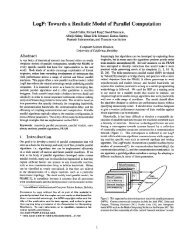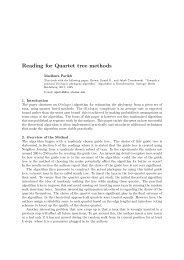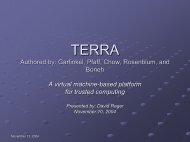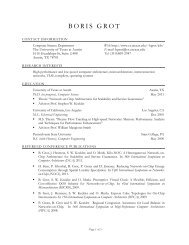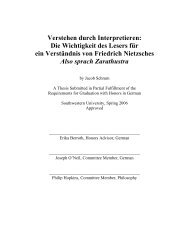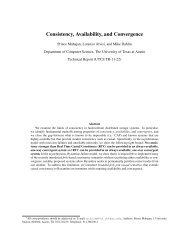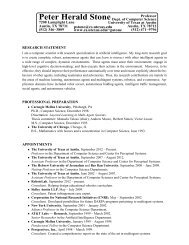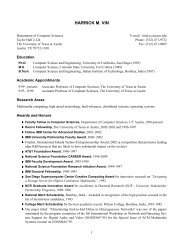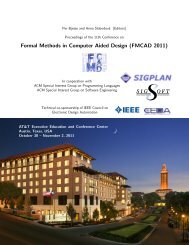A User's Guide to gringo, clasp, clingo, and iclingo
A User's Guide to gringo, clasp, clingo, and iclingo
A User's Guide to gringo, clasp, clingo, and iclingo
You also want an ePaper? Increase the reach of your titles
YUMPU automatically turns print PDFs into web optimized ePapers that Google loves.
in the initial state (time point 0). Then we model the state transition using the rules<br />
in Line 6 <strong>and</strong> 7. The first rule is quite straightforward <strong>and</strong> states that the moved disc<br />
changes its location. Note the usage of not moves(T) here. This literal prevents<br />
deriving an infinite number of rules, which would be all useless because the state no<br />
longer changes after the last move. The second rule makes sure that all discs that are<br />
not moved stay where they are. Finally, we define the auxiliary predicate blocked/3,<br />
which marks positions w.r.t. pegs that cannot be moved from. First in Line 8, the position<br />
below a disc on some peg is blocked. Second in Line 9, the position directly below<br />
a blocked position is blocked. Note that we mark position zero <strong>to</strong> be blocked, <strong>to</strong>o. This<br />
is convenient later on <strong>to</strong> assert some redundant moves.<br />
Finally, there is the Test part building upon both Generate <strong>and</strong> Define part <strong>to</strong> rule<br />
out wrong moves that do not agree with the problem description. It consists solely of<br />
integrity constraints, which fail whenever all their literals are true. The first integrity<br />
constraint in Line 11 asserts that a disc that is blocked, i.e, with some disc on <strong>to</strong>p,<br />
cannot be moved. Note the usage of D-1 here, this way a disc cannot be put back <strong>to</strong> the<br />
same location again. The integrity constraint in Line 12 asserts that a disc can only be<br />
placed on <strong>to</strong>p of a bigger disc. Line 13 asserts the goal situation. To make the encoding<br />
more efficient, we add a redundant constraint in Line 14, which asserts that each disc at<br />
all time points is located on exactly one peg. Although, this constraint is implied by the<br />
constraints above, adding this additional domain knowledge greatly improves the speed<br />
with which the problem can be solved. Finally, the last two statements control which<br />
predicates are printed, when a satisfying model for the instance is found. Here we first<br />
hide all predicates (Line 15) <strong>and</strong> then explicitly show only the move/3 predicate (Line<br />
16).<br />
2.3 Problem Solution<br />
Now we are ready <strong>to</strong> solve the encoded puzzle. To find an answer set, invoke one<br />
of the following comm<strong>and</strong>s (<strong>clingo</strong>, or <strong>gringo</strong> <strong>and</strong> <strong>clasp</strong> have <strong>to</strong> be installed<br />
somewhere under the systems path for the comm<strong>and</strong>s below <strong>to</strong> work):<br />
<strong>clingo</strong><br />
<strong>gringo</strong> | <strong>clasp</strong><br />
Note that (depending on your viewer) you can right or double-click on file names<br />
marked with a red font <strong>to</strong> safe the associated file <strong>to</strong> disc. This is possible with all<br />
examples given in this document.<br />
The output of the solver (<strong>clingo</strong> in this case) looks something like that:<br />
Answer: 1<br />
move(4,b,1) move(3,c,2) move(4,c,3) move(2,b,4) \<br />
move(4,a,5) move(3,b,6) move(4,b,7) move(1,c,8) \<br />
move(4,c,9) move(3,a,10) move(4,a,11) move(2,c,12) \<br />
move(4,b,13) move(3,c,14) move(4,c,15)<br />
SATISFIABLE<br />
Models : 1+<br />
Time : 0.010<br />
Prepare : 0.000<br />
Prepro. : 0.010<br />
Solving : 0.000<br />
8



